We may not have the course you’re looking for. If you enquire or give us a call on +08000201623 and speak to our training experts, we may still be able to help with your training requirements.
Training Outcomes Within Your Budget!
We ensure quality, budget-alignment, and timely delivery by our expert instructors.
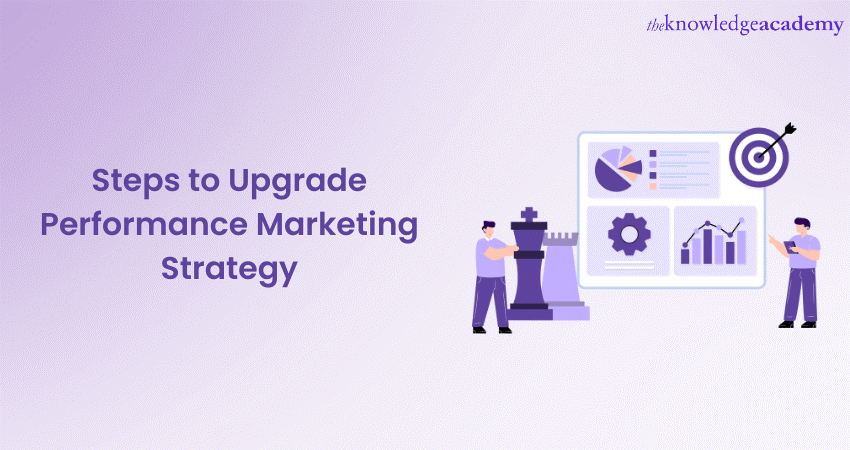
The market is constantly changing with the emergence of new competitors and existing ones updating their marketing tactics. In such a scenario, using the same old strategy can put you behind innovative rivals. Upgraded Performance Marketing Strategy keeps you competitive and relevant in your industry.
For instance, a few years ago, businesses had to adjust their strategies to cater to the boom in smartphone usage. More recently, they've had to consider voice search, augmented reality, and AI-driven personalisation. So, if you, too, want to keep up with the market pace, it’s time to familiarise yourself with certain strategies to survive and thrive in the market. Read this blog to learn about the nine steps to elevate your Performance Marketing Strategy, especially during periods when consumers are more willing to spend.
Table of Contents
1) What is a Performance Marketing Strategy?
2) Audit your current strategy
3) Setting clear objectives
4) Segment your audience
5) Optimise your landing pages
6) Leverage A/B testing
7) Dive deeper with data analytics
8) Embrace multi-channel marketing
9) Personalise user experiences
10) Re-evaluate and adapt
11) Conclusion
What is a Performance Marketing Strategy?
Performance Marketing is a digital-era marvel. It pivots on outcomes that are clearly measurable. While traditional marketing leans heavily on brand promotion, Performance Marketing seeks tangible actions. These can be as simple as website clicks or as significant as product sales and new email sign-ups.
The heart of this approach is Return On Investment (ROI). Every marketing move aims to yield a definitive return on the invested money. The real-time nature of digital platforms makes this strategy shine. Marketers can see Performance Marketing campaign results almost instantaneously, allowing for swift adjustments.
Moreover, data is the fuel that drives this strategy. Each decision stems from patterns, user behaviours, and analytics. Immediate feedback is crucial. It ensures the Marketing Strategy remains agile, catering to real-time demands and challenges.
Cost models in Performance Marketing are also distinctive. The focus is on performance metrics, whether it's a clicked ad (Pay Per Click) or a successful sale (Cost Per Ad). This structure offers a clear vision of what's working and what's not, making budget allocations more effective.
The versatility of channels used is noteworthy. From tapping into affiliate networks to optimising search engine results and leveraging paid ads, there's a wide playing field. The strategy's adaptability is one of its greatest strengths. Performance Marketing can be tailored, retargeted, or overhauled based on real-time performance.
Boost your marketing skills now with our Performance Marketing Training.
Audit your current strategy
Auditing your current strategy is akin to a health check-up for your marketing efforts. It reveals strengths to capitalise on and weaknesses that need addressing. Periodic audits ensure that your strategy remains effective and aligned with your business objectives. Here are five ways you can audit your current Performance Marketing Strategy:
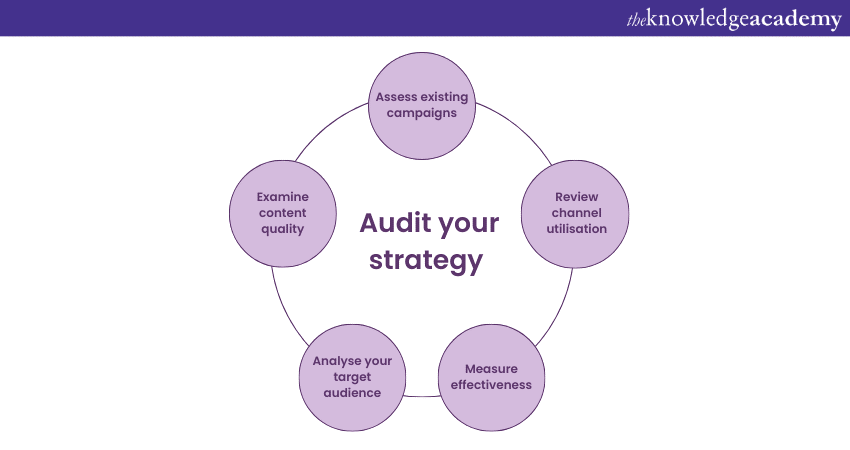
Assess existing campaigns
Every Performance Marketing Strategy has various active Performance Marketing campaigns. Evaluate each campaign's specific goals and objectives. Look at the platforms they're hosted on. Consider their duration and reach. Also, check if they're short-term promotions or long-term brand-building initiatives. These insights can provide a holistic view of ongoing efforts.
Review channel utilisation
Modern marketing utilises multiple channels. From Facebook and Instagram to email newsletters and Pay Per Click (PPC) ads, each channel serves a purpose. So, determine where most of your content is posted. Recognise underused platforms that might offer untapped potential. Channel diversification can amplify reach and influence.
Measure effectiveness
Metrics offer a numerical insight into Performance Marketing campaign success. Delve into performance metrics like conversion rates. Investigate how many visitors are turning into customers. Further, compare customer acquisition costs across campaigns. This numerical deep dive helps gauge the real value of each marketing effort.
Analyse target audience relevance
Assess if your Performance Marketing campaigns cater to their interests and needs. Are they tailored for young adults or professionals? Ensure your messaging aligns with the audience’s demographics. A misalignment can result in lost engagement and conversions.
Examine content quality
Review the actual content pieces, be they blog posts, videos, or infographics. Also, check for relevancy, accuracy, and engagement potential. High-quality content not only attracts but also retains audience attention, fostering brand loyalty.
Setting clear objectives
Every campaign begins with an underlying purpose or motivation. Grasping the 'why' behind this purpose offers direction and clarity. A brand might launch a campaign for various reasons. This could be introducing a new product, engaging with a younger audience, or entering a new market segment.
The 'why' serves as the bedrock, dictating the campaign's tone, content, and delivery channels. By clarifying this reason early, brands can ensure alignment across all marketing activities and messages. Here's how to do it:
Tangible vs. intangible goals
Every objective can be broadly categorised into two types. Tangible goals are concrete, offering clear metrics for success. This could mean targeting a set number of sales or clicks. On the other hand, intangible goals, although abstract, hold immense value. These relate to perceptions, feelings, and brand image. For instance, enhancing brand trust or improving customer sentiment. Recognising the difference and the need for both can create a holistic Performance Marketing Strategy.
Specificity matters
Ambiguous goals can lead to scattered efforts. A desire for increased website traffic is vague. However, for example, aiming for a 20% rise in website traffic over three months provides a clear target. Such specificity offers a tangible metric, streamlines efforts, and facilitates precise performance measurement. It also ensures that all team members are aligned in their understanding and efforts.
Quantifiable outcomes
Quantifiable goals facilitate clear assessment. Suppose a brand aims to increase email subscribers; a quantifiable version will be specified by 500 subscribers. This clarity not only sets a benchmark but also simplifies the evaluation of the Performance Marketing campaign. It allows for data-driven analysis, leading to more informed future strategies.

Timelines are essential
A deadline imparts urgency, ensures timely execution, and aids in resource allocation. Whether the objective is to boost sales during a festive season or grow followers over a year, setting a clear end date is pivotal. Timelines keep teams on track and prevent perpetual postponement of tasks.
Prioritise your objectives
While multiple objectives can coexist, their importance may vary. Distinguishing primary goals from secondary ones helps in effective resource distribution. A brand might deem entering a new market as a primary goal, whereas a secondary one could be tweaking the colour scheme of its website. This distinction ensures that effort and money are appropriately channelled.
Segment your audience
Segmenting an audience may initially seem labour-intensive. However, the benefits far outweigh the efforts. With segmentation, brands can deliver more personalised, relevant content. This increases the likelihood of positive engagement, fostering brand loyalty and driving conversions. Here's how:
Demographic segmentation
This involves categorising based on age, gender, income, education, and occupation. A brand selling luxury watches, for instance, might target high-income professionals. Meanwhile, a youth-focused app might prioritise the 18-25 age bracket. By understanding these demographics, a Performance Marketing Strategy can be more precisely made.
Geographic segmentation
Geographic segmentation focuses on location-specific preferences and behaviours. This could be as broad as continents or as specific as neighbourhoods. A local restaurant might focus on nearby residents, while a global brand might tweak campaigns for various countries, considering cultural nuances.
Behavioural segmentation
Behavioural segmentation observes product usage rates, brand interactions, and purchasing habits. For instance, a frequent online shopper might receive more frequent promotional emails compared to a once-a-year shopper. Tailoring to such behaviours can increase engagement and conversion rates.
Psychographic segmentation
Beyond tangible metrics, there are attitudes, values, and lifestyles. Psychographic segmentation dives into these aspects. For example, a brand promoting eco-friendly products might target individuals passionate about sustainability. Understanding these deeper preferences allows brands to resonate more profoundly with their audience.
Benefit segmentation
Every customer seeks specific benefits from products or services. Some might prioritise quality, others affordability, and yet others speed. Catering to these distinct desires ensures customer satisfaction. For instance, a software company might offer both a feature-rich premium version and a basic, affordable version, catering to different benefit segments.
Regularly update segmentation data:
The world is dynamic, and so are audiences. Regular reviews of segmentation data are essential. As audience behaviours and preferences shift, so should the segmentation strategy. This iterative process ensures that brands remain relevant and in tune with their audience’s evolving needs.
Elevate your digital capabilities with our Digital Marketing Courses. Join today!
Optimise your landing pages
A landing page is more than just a webpage; it's a strategic tool. Each element, from design to content, plays a unique role in guiding user interactions and decisions. With constant optimisation, it becomes an asset, consistently driving conversions and strengthening brand-user relationships. The following are a few factors that can have a positive effect on your landing pages:
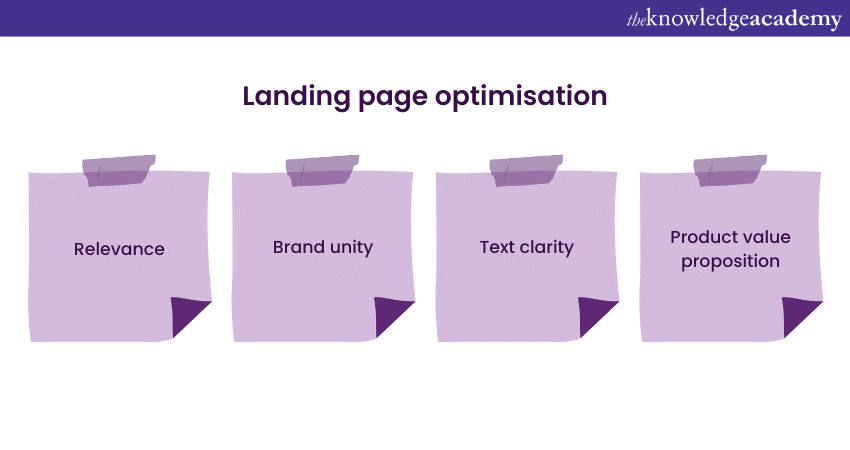
Clear and compelling headlines
An engaging headline is the hook. It captures attention and sets expectations for the content that follows. They can be beneficial as they:
a) Dictate the user's first impression.
b) Directly linked to user engagement.
c) Drive curiosity and interest.
d) Align with the user's search intent.
Loading speed matters
Slow-loading pages deter visitors, leading to missed conversion opportunities. They can have the following impact:
a) Influence on bounce rate.
b) Effect on SEO rankings.
c) Directly related to user satisfaction.
d) Impact on overall site credibility.
Mobile responsiveness
Mobile browsing dominates. A non-responsive page risks losing a significant user base and potential conversions. This mobile responsiveness is crucial because of the following reasons:
a) Essential for multi-device users.
b) Improves user experience.
c) Influential in SEO rankings.
d) Enhances page accessibility.
Effective Call To Action (CTA)
The CTA is a beacon. It directs users on the desired path, influencing actions and decisions. It helps in the following manner:
a) Determines user interactions.
b) Influences conversion rates.
c) Clarifies the next steps.
d) Reflects the page's primary goal.
Visual elements
Visuals enhance comprehension. Relevant and high-quality visuals engage users and complement textual content. They help in the following manner:
a) Increase user engagement time.
b) Enhance message clarity.
c) Improve aesthetic appeal.
d) Can simplify complex information.
Minimalist design
Less often means more. A clutter-free design ensures users focus on essential elements without distraction. Thus, it’s crucial to add minimalistic design because:
a) Prioritises important content.
b Enhances user navigation.
c) Reduces potential confusion.
d) Amplifies main messaging.
Trust indicators
Trust forms the foundation. Indicators reinforce credibility and assure users of authenticity. It further helps in the following ways:
a) Boosts user confidence.
b) Increases likelihood of conversions.
c) Demonstrates brand transparency.
d) Validates brand claims and offerings.
Leverage A/B testing
By comparing different versions and relying on real user interactions, brands can refine their webpages based on concrete data. It replaces assumptions with insights, ensuring that each design decision aligns with user preferences and needs. A/B testing is an indispensable tool, continually pushing the boundaries of user engagement and conversion optimisation. The following figure will help you understand it better.
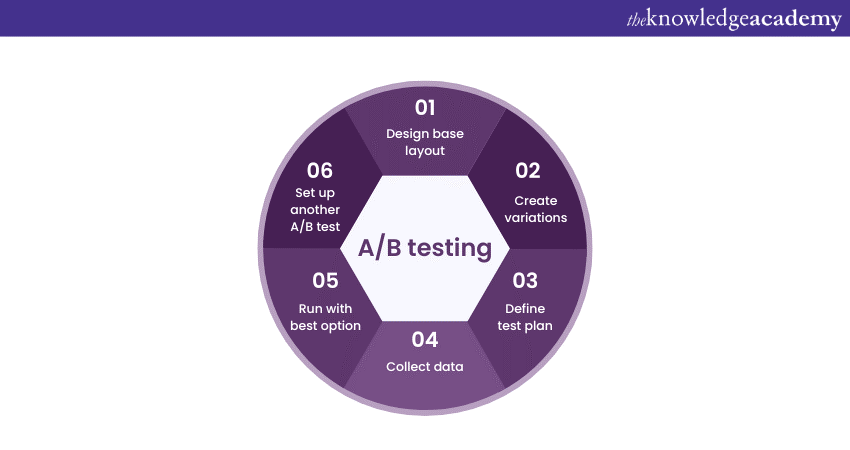
Importance of hypothesis creation
Before testing, formulate a hypothesis. This prediction guides the test, specifying what change might lead to improved performance. A hypothesis has the following:
a) Defines test objectives.
b) Focuses on potential improvement areas.
c) Offers a metric for success.
d) Ensures a structured testing approach.
Picking the right variables
Every element on a page can be tested. However, it's crucial to choose variables that likely impact user behaviour. Variables can be CTAs, images, or text that can help in the following manner:
a) Drive meaningful test outcomes.
b) Ensure resource-effective testing.
c) Prioritise impactful page elements.
Segmenting audience for tests
Different audience segments might respond differently. By segmenting, results become more accurate and actionable.
a) Enhances test relevancy.
b) Captures diverse user behaviour.
c) Allows targeted optimisation.
d) Reduces skewed results.
Analysing results effectively
Post-test, delve into results. Understand not just which version won but also why it resonated better with users. This can be beneficial as it provides:
a) Actionable insights
b)Informed decisions
c) User preferences
d) Future optimisation strategies
Dive deeper with Data Analytics
Businesses continually collect vast amounts of data through effective analysis, which guides brands towards informed decisions. Embracing Data Analytics isn't just about numbers; it's about leveraging that knowledge for continuous growth and improvement. Data Analytics:
a) Unveils hidden patterns.
b) Supports informed decisions.
c) Elevates user understanding.
d) Fuels strategic planning.
Tools and platforms used for Data Analytics
Various tools exist to facilitate Data Analytics. Platforms like Google Analytics, Mixpanel, and Tableau help capture and interpret data. Here's how they provide assistance:
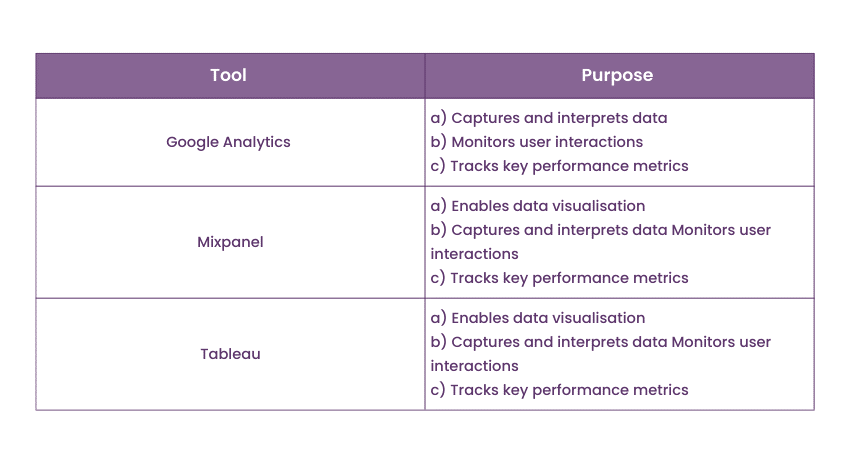
Segment data for clarity
Breaking data into segments, such as by user demographics or behaviour, can highlight specific patterns or opportunities. It is beneficial as it:
a) Allows targeted analysis.
b) Pinpoints specific user groups.
c) Reveals nuanced insights.
d) Enhances personalisation efforts.
Predictive analytics
This advanced analytics type forecasts future trends based on historical data, aiding in proactive decision-making. Predictive analytics is further helps because it:
a) Anticipates user needs.
b) Drives pre-emptive strategies.
c) Optimises resource allocation.
d) Minimises potential risks.
Master the art of data-driven marketing with our Data-Driven Marketing Masterclass. Join today!
Embrace multi-channel Marketing
Multi-channel Marketing revolves around promoting products or services across various communication platforms. It's not just about presence but ensuring a strong brand voice and message across all channels. By tapping into multiple platforms, businesses can reach wider audiences and ensure their brand remains top-of-mind.
Multi-channel Marketing increases visibility. With consumers scattered across different platforms, having a multi-pronged approach means brands can meet users where they spend their time. This not only increases the chance of message reception but also allows for tailored messaging according to the platform's specific audience.
However, not all channels may be right for a particular brand or Performance Marketing campaign. It's vital to understand each platform's audience, capabilities, and limitations. By doing so, businesses can prioritise channels that align with their goals, budget, and target demographic, ensuring a more impactful presence.
While each platform may require a tailored Performance Marketing Strategy, it's crucial for the brand voice and messaging to remain consistent. This ensures that regardless of where a consumer interacts with a brand, they receive a coherent and consistent brand experience, fostering trust and brand recall.
Personalise user experiences
Personalisation has come to prominence as a tool to engage audiences more effectively. It's the practice of tailoring experiences based on individual user data, behaviours, and preferences. Every user interaction offers insights. By tracking these, brands can deliver content that feels tailored to individual needs. For instance, e-commerce sites suggest products based on browsing history. Similarly, streaming platforms recommend shows based on viewing habits.
Moreover, personalisation can transcend digital spaces. Customer service, for example, benefits from prior knowledge of a customer's interactions. Personalisation's essence lies in its ability to make users feel valued. When a brand seems to know its audience, trust is established. This connection often leads to enhanced user loyalty, longer engagement, and increased conversions.
Re-evaluate and adapt
As consumer behaviours, market trends, and technological advancements shift, strategies that once thrived may lose efficacy. This ever-changing landscape necessitates periodic re-evaluation of marketing approaches.
Regular reviews enable brands to pinpoint what's working and what's not. By assessing Performance Marketing campaign metrics, feedback, and ROI, businesses can gain clarity on areas needing adjustment. But evaluation alone isn't enough; adaptation is crucial.
Brands must be agile, and willing to pivot strategies based on insights garnered. This proactive approach ensures sustained relevance in the market. The cycle of re-evaluation and adaptation keeps businesses ahead of the curve, ensuring their marketing efforts remain impactful and resonate with their target audience.
Conclusion
The more you market, the more data you accumulate about your audience's preferences, behaviours, and pain points. Regularly revisiting and upgrading your Performance Marketing Strategy lets you leverage this data, refining your approach for better results.
Dive into the world of influencer marketing with our Influencer Marketing Masterclass.Register now!
Frequently Asked Questions
Upcoming Digital Marketing Resources Batches & Dates
Date
 Digital Marketing Course
Digital Marketing Course
Fri 17th Jan 2025
Fri 21st Feb 2025
Fri 4th Apr 2025
Fri 6th Jun 2025
Fri 25th Jul 2025
Fri 7th Nov 2025
Fri 26th Dec 2025







 Top Rated Course
Top Rated Course


 If you wish to make any changes to your course, please
If you wish to make any changes to your course, please


